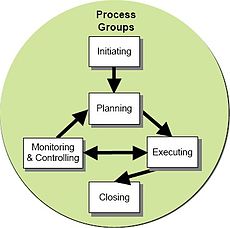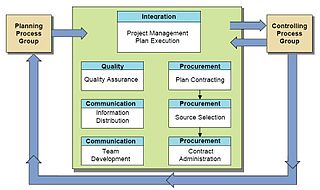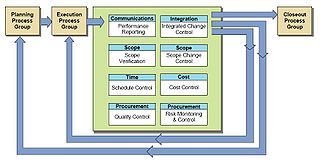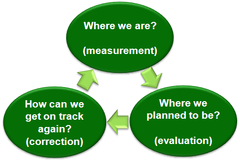Processes
Traditionally, project management includes a number of elements: four to five project management process groups, and a control system. Regardless of the methodology or terminology used, the same basic project management processes will be used. Major process groups generally include:[7]
- Initiation
- Planning
- Production or execution
- Monitoring and controlling
- Closing
In project environments with a significant exploratory element (e.g., research and development), these stages may be supplemented with decision points (go/no go decisions) at which the project's continuation is debated and decided. An example is the Phase–gate model.
Initiating[edit]
The initiating processes determine the nature and scope of the project.[27] If this stage is not performed well, it is unlikely that the project will be successful in meeting the business’ needs. The key project controls needed here are an understanding of the business environment and making sure that all necessary controls are incorporated into the project. Any deficiencies should be reported and a recommendation should be made to fix them.
The initiating stage should include a plan that encompasses the following areas:
- analyzing the business needs/requirements in measurable goals
- reviewing of the current operations
- financial analysis of the costs and benefits including a budget
- stakeholder analysis, including users, and support personnel for the project
- project charter including costs, tasks, deliverables, and schedules
Planning
After the initiation stage, the project is planned to an appropriate level of detail (see example of a flow-chart).[26] The main purpose is to plan time, cost and resources adequately to estimate the work needed and to effectively manage risk during project execution. As with the Initiation process group, a failure to adequately plan greatly reduces the project's chances of successfully accomplishing its goals.
Project planning generally consists of[28]
- determining how to plan (e.g. by level of detail or Rolling Wave planning);
- developing the scope statement;
- selecting the planning team;
- identifying deliverables and creating the work breakdown structure;
- identifying the activities needed to complete those deliverables and networking the activities in their logical sequence;
- estimating the resource requirements for the activities;
- estimating time and cost for activities;
- developing the schedule;
- developing the budget;
- risk planning;
- gaining formal approval to begin work.
Additional processes, such as planning for communications and for scope management, identifying roles and responsibilities, determining what to purchase for the project and holding a kick-off meeting are also generally advisable.
For new product development projects, conceptual design of the operation of the final product may be performed concurrent with the project planning activities, and may help to inform the planning team when identifying deliverables and planning activities.
Executing
The execution/implementation phase ensures that the project management plan’s deliverables are executed accordingly. This phase involves proper allocation, co-ordination and management of human resources and any other resources such as material and budgets. The output of this phase is the project deliverables.
Monitoring and controlling
Monitoring and controlling consists of those processes performed to observe project execution so that potential problems can be identified in a timely manner and corrective action can be taken, when necessary, to control the execution of the project. The key benefit is that project performance is observed and measured regularly to identify variances from the project management plan.
Monitoring and controlling includes:[29]
- Measuring the ongoing project activities ('where we are');
- Monitoring the project variables (cost, effort, scope, etc.) against the project management plan and the project performance baseline (where we should be);
- Identify corrective actions to address issues and risks properly (How can we get on track again);
- Influencing the factors that could circumvent integrated change control so only approved changes are implemented.
In multi-phase projects, the monitoring and control process also provides feedback between project phases, in order to implement corrective or preventive actions to bring the project into compliance with the project management plan.
Project maintenance is an ongoing process, and it includes:[7] 1 Continuing support of end-users 2 Correction of errors 3 Updates of the software over time
In this stage, auditors should pay attention to how effectively and quickly user problems are resolved.
Over the course of any construction project, the work scope may change. Change is a normal and expected part of the construction process. Changes can be the result of necessary design modifications, differing site conditions, material availability, contractor-requested changes, value engineering and impacts from third parties, to name a few. Beyond executing the change in the field, the change normally needs to be documented to show what was actually constructed. This is referred to as change management. Hence, the owner usually requires a final record to show all changes or, more specifically, any change that modifies the tangible portions of the finished work. The record is made on the contract documents – usually, but not necessarily limited to, the design drawings. The end product of this effort is what the industry terms as-built drawings, or more simply, “as built.” The requirement for providing them is a norm in construction contracts. Construction document management is a highly important task undertaken with the aid an online or desktop software system, or maintained through physical documentation. The increasing legality pertaining to the construction industries maintenance of correct documentation has caused the increase in the need for document management systems.
When changes are introduced to the project, the viability of the project has to be re-assessed. It is important not to lose sight of the initial goals and targets of the projects. When the changes accumulate, the forecasted result may not justify the original proposed investment in the project. Successful project management identifies these components, and tracks and monitors progress so as to stay within time and budget frames already outlined at the commencement of the project.
Closing
Closing includes the formal acceptance of the project and the ending thereof. Administrative activities include the archiving of the files and documenting lessons learned.
This phase consists of:[7]
- Contract closure: Complete and settle each contract (including the resolution of any open items) and close each contract applicable to the project or project phase.
- Project close: Finalize all activities across all of the process groups to formally close the project or a project phase
Also included in this phase is the Post Implementation Review. This is a vital phase of the project for the project team to learn from experiences and apply to future projects. Normally a Post Implementation Review consists of looking at things that went well and analysing things that went badly on the project to come up with lessons learned.
Project controlling and project control systems
Project controlling should be established as an independent function in project management. It implements verification and controlling function during the processing of a project in order to reinforce the defined performance and formal goals.[30] The tasks of project controlling are also:
- the creation of infrastructure for the supply of the right information and its update
- the establishment of a way to communicate disparities of project parameters
- the development of project information technology based on an intranet or the determination of a project key performance indicator system (KPI)
- divergence analyses and generation of proposals for potential project regulations[31]
- the establishment of methods to accomplish an appropriate project structure, project workflow organization, project control and governance
- creation of transparency among the project parameters[32]
Fulfillment and implementation of these tasks can be achieved by applying specific methods and instruments of project controlling. The following methods of project controlling can be applied:
- investment analysis
- cost–benefit analysis
- value benefit analysis
- expert surveys
- simulation calculations
- risk-profile analysis
- surcharge calculations
- milestone trend analysis
- cost trend analysis
- target/actual-comparison[33]
Project control is that element of a project that keeps it on-track, on-time and within budget.[29] Project control begins early in the project with planning and ends late in the project with post-implementation review, having a thorough involvement of each step in the process. Projects may be audited or reviewed while the project is in progress. Formal audits are generally risk or compliance-based and management will direct the objectives of the audit. An examination may include a comparison of approved project management processes with how the project is actually being managed.[34] Each project should be assessed for the appropriate level of control needed: too much control is too time consuming, too little control is very risky. If project control is not implemented correctly, the cost to the business should be clarified in terms of errors and fixes.
Control systems are needed for cost, risk, quality, communication, time, change, procurement, and human resources. In addition, auditors should consider how important the projects are to the financial statements, how reliant the stakeholders are on controls, and how many controls exist. Auditors should review the development process and procedures for how they are implemented. The process of development and the quality of the final product may also be assessed if needed or requested. A business may want the auditing firm to be involved throughout the process to catch problems earlier on so that they can be fixed more easily. An auditor can serve as a controls consultant as part of the development team or as an independent auditor as part of an audit.
Businesses sometimes use formal systems development processes. These help assure that systems are developed successfully. A formal process is more effective in creating strong controls, and auditors should review this process to confirm that it is well designed and is followed in practice. A good formal systems development plan outlines:
- A strategy to align development with the organization’s broader objectives
- Standards for new systems
- Project management policies for timing and budgeting
- Procedures describing the process
- Evaluation of quality of change
Topics
Project managers
A project manager is a professional in the field of project management. Project managers can have the responsibility of the planning, execution, and closing of any project, typically relating to construction industry, engineering, architecture, computing, and telecommunications. Many other fields in production engineering, design engineering, and heavy industrial have project managers.
A project manager is the person accountable for accomplishing the stated project objectives. Key project management responsibilities include creating clear and attainable project objectives, building the project requirements, and managing the triple constraint for projects, which is cost, time, and scope.
A project manager is often a client representative and has to determine and implement the exact needs of the client, based on knowledge of the firm they are representing. The ability to adapt to the various internal procedures of the contracting party, and to form close links with the nominated representatives, is essential in ensuring that the key issues of cost, time, quality and above all, client satisfaction, can be realized.
Project management types
While Project management, by itself, is a discipline that can apply to any project intended to deliver solutions for any purpose, it is often tailored to accommodate the specific and repeatable needs of different and highly specialized industries. For example, the construction industry, which focuses on the delivery of things like buildings, roads, and bridges, has developed its own specialized form of project management that it refers to as Construction project management and for which project managers can become trained and certified in.[35] The Information technology industry has also evolved to develop its own form of Project management that is referred to as IT Project management and which specializes in the delivery of technical assets and services that are required to pass through various lifecycle phases such as planning, design, development, testing, and deployment. Biotechnology project management focuses on the intricacies of biotechnology research and development.[36]
For each type of project management, project managers develop and utilize repeatable templates that are specific to the industry they're dealing with. This allows project plans to become very thorough and highly repeatable, with the specific intent to increase quality, lower delivery costs, and lower time to deliver project results.
Work breakdown structure[edit]
Main article: Work breakdown structure
The work breakdown structure (WBS) is a tree structure that shows a subdivision of effort required to achieve an objective—for example a program, project, and contract. The WBS may be hardware-, product-, service-, or process-oriented (see an example in a NASA reporting structure (2001)).[37]
A WBS can be developed by starting with the end objective and successively subdividing it into manageable components in terms of size, duration, and responsibility (e.g., systems, subsystems, components, tasks, sub-tasks, and work packages), which include all steps necessary to achieve the objective.[21]
The work breakdown structure provides a common framework for the natural development of the overall planning and control of a contract and is the basis for dividing work into definable increments from which the statement of work can be developed and technical, schedule, cost, and labor hour reporting can be established.[37] The work breakdown structure can be displayed in two forms one in form of a table with subdivision of tasks two in form of an organisational chart.
International standards[edit]
There have been several attempts to develop project management standards, such as:
- ISO 21500: 2012 - Guidance on project management. This is the first project management ISO.
- ISO 31000: 2009 - Risk management. Risk management is 1 of the 10 knowledge areas of either ISO 21500 or PMBoK5 concept of project management.
- ISO/IEC/IEEE 16326-2009 - Systems and Software Engineering—Life Cycle Processes—Project Management [38]
- Capability Maturity Model from the Software Engineering Institute.
- GAPPS, Global Alliance for Project Performance Standards – an open source standard describing COMPETENCIES for project and program managers.
- A Guide to the Project Management Body of Knowledge from the Project Management Institute (PMI)
- HERMES method, Swiss general project management method, selected for use in Luxembourg and international organizations.
- The ISO standards ISO 9000, a family of standards for quality management systems, and the ISO 10006:2003, for Quality management systems and guidelines for quality management in projects.
- PRINCE2, Projects IN Controlled Environments.
- Association for Project Management Body of Knowledge[39]
- Team Software Process (TSP) from the Software Engineering Institute.
- Total Cost Management Framework, AACE International's Methodology for Integrated Portfolio, Program and Project Management.
- V-Model, an original systems development method.
- The Logical framework approach, which is popular in international development organizations.
- IAPPM, The International Association of Project & Program Management, guide to project auditing and rescuing troubled projects.
- [Australian Institute of Project Management] AIPM has 4 levels of certification; CPPP, CPPM, CPPD & CPPE for Certified Practicing Project ... Partner, Manager, Director and Executive.







No comments:
Post a Comment